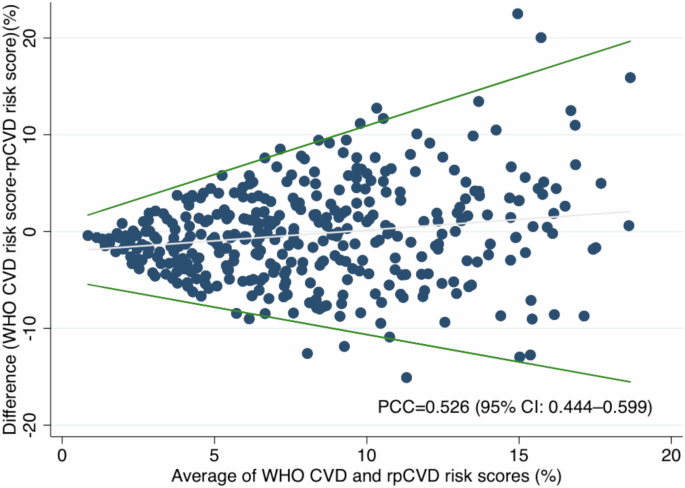摘要
我们旨在评估澳大利亚初级医疗机构中基于视网膜自动摄影和人工智能(AI)的心血管疾病(CVD)风险评估系统(rpCVD)的实际准确性(主要结果)、可行性和可接受性(次要结果)。研究人员从澳大利亚维多利亚州的两家全科诊所招募了年龄在45-70岁之间、近期接受过全部或部分心血管疾病风险评估的参与者。在征得同意后,参与者使用自动眼底照相机进行了视网膜成像,并通过深度学习算法生成了rpCVD风险评分。该评分与世界卫生组织(WHO)心血管疾病风险评分进行了比较,后者包含了年龄、性别和其他临床风险因素。利用英国生物库的数据评估了rpCVD和WHO心血管疾病风险评分对10年心血管疾病事件的预测准确性,并通过接收者工作特征曲线下面积(AUC)评估了每个系统的准确性。参与者的满意度通过调查进行评估,成像成功率则根据图像质量足以得出rpCVD风险评分的个人百分比来确定。在 361 名参与者中,339 人获得了 rpCVD 风险评分,成像成功率为 93.9%。rpCVD 风险评分与世界卫生组织心血管疾病风险评分呈中度相关性(皮尔逊相关系数 [PCC] = 0.526,95% CI:0.444-0.599)。尽管如此,仅依靠视网膜图像的 rpCVD 系统在预测 10 年心血管疾病发病率方面的准确度(AUC = 0.672,95% CI:0.658-0.686)与世界卫生组织心血管疾病风险评分(AUC = 0.693,95% CI:0.680-0.707)相近。据报道,92.5%的参与者和87.5%的全科医生(GPs)对该系统表示满意,满意率很高。自动 rpCVD 系统仅使用视网膜照片,其预测准确性与世界卫生组织心血管疾病风险评分不相上下,后者纳入了包括年龄在内的多种临床因素,而年龄是心血管疾病预测中权重最高的因素。这凸显了 rpCVD 方法的潜力,它是初级医疗机构进行心血管疾病风险评估的一种更快、更简便、无创的替代方法,避免了对更复杂的临床程序的需求。

We aim to assess the real-world accuracy (primary outcome), feasibility and acceptability (secondary outcomes) of an automated retinal photography and artificial intelligence (AI)-based cardiovascular disease (CVD) risk assessment system (rpCVD) in Australian primary care settings. Participants aged 45–70 years who had recently undergone all or part of a CVD risk assessment were recruited from two general practice clinics in Victoria, Australia. After consenting, participants underwent retinal imaging using an automated fundus camera, and an rpCVD risk score was generated by a deep learning algorithm. This score was compared against the World Health Organisation (WHO) CVD risk score, which incorporates age, sex, and other clinical risk factors. The predictive accuracy of the rpCVD and WHO CVD risk scores for 10-year incident CVD events was evaluated using data from the UK Biobank, with the accuracy of each system assessed through the area under the receiver operating characteristic curve (AUC). Participant satisfaction was assessed through a survey, and the imaging success rate was determined by the percentage of individuals with images of sufficient quality to produce an rpCVD risk score. Of the 361 participants, 339 received an rpCVD risk score, resulting in a 93.9% imaging success rate. The rpCVD risk scores showed a moderate correlation with the WHO CVD risk scores (Pearson correlation coefficient [PCC] = 0.526, 95% CI: 0.444–0.599). Despite this, the rpCVD system, which relies solely on retinal images, demonstrated a similar level of accuracy in predicting 10-year incident CVD (AUC = 0.672, 95% CI: 0.658-0.686) compared to the WHO CVD risk score (AUC = 0.693, 95% CI: 0.680-0.707). High satisfaction rates were reported, with 92.5% of participants and 87.5% of general practitioners (GPs) expressing satisfaction with the system. The automated rpCVD system, using only retinal photographs, demonstrated predictive accuracy comparable to the WHO CVD risk score, which incorporates multiple clinical factors including age, the most heavily weighted factor for CVD prediction. This underscores the potential of the rpCVD approach as a faster, easier, and non-invasive alternative for CVD risk assessment in primary care settings, avoiding the need for more complex clinical procedures.

 求助内容:
求助内容: 应助结果提醒方式:
应助结果提醒方式:


